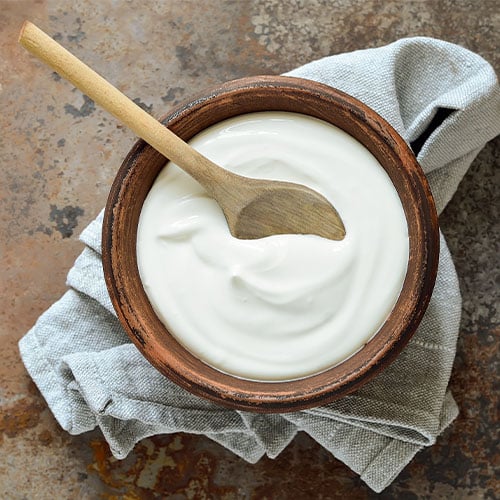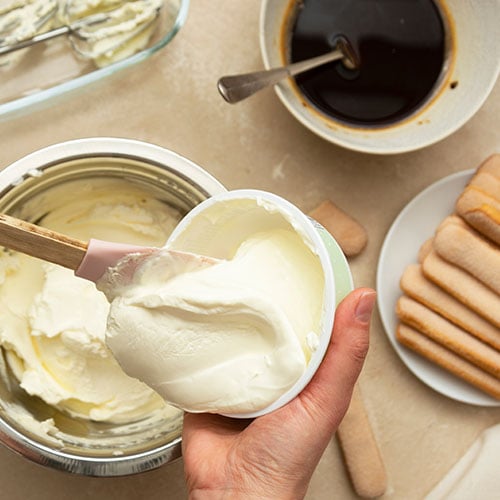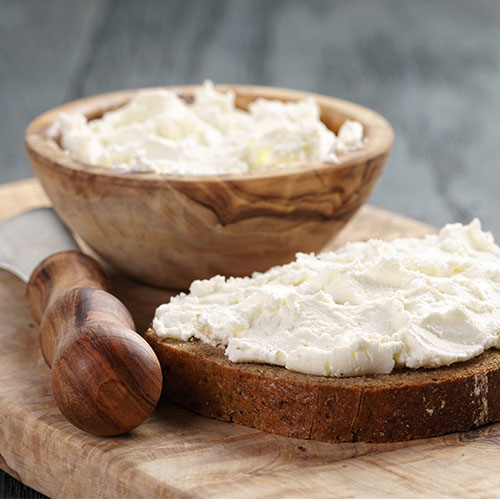Fine dining is typically associated with pristine tablescapes and the pleasant aromas of French mother sauces simmering in the kitchen. Subverting expectations, white tablecloth establishments are also full of odiferous ingredients ranging from truffles to stinky cheese. It's not uncommon to have a smelly cheese board served alongside caviar. We walk you through the most popular stinky cheeses and explain what gives them their putrid aroma so you can incorporate them tactfully into your restaurant menu. Skip to the stinky cheese that interests you: 1. Raclette 2. Gruyere 3. Camembert 4. Taleggio 5. Brick Cheese 6. Limburger 7. Stinking Bishop 8. Maroilles 9. Tomme de Chevre 10. Epoisses de Bourgogne Why Does Cheese Stink? Stinky cheeses are types of cheese known for their rank odors that some liken to the smell of sweaty socks, and they're not far off! Stinky cheeses contain the bacteria Brevibacterium linens, which is closely related to Brevibacterium epidermidis, commonly found in the sweaty crevasses of our feet. While their smells may be off-putting, their rich and funky flavors can add serious depth to a cheese board or menu item. We explain the various factors that contribute to stinky cheeses' powerful odors below: Bacteria and Mold: Stinky cheeses are typically made with specific strains of bacteria and molds that contribute to their strong smell. These microorganisms help break down the proteins and fats in the cheese, creating compounds that give off the signature funky aroma. Ripening Process: During aging, the cheese undergoes chemical changes that release volatile compounds responsible for the distinctive odor. Washed Rind: Many stinky cheeses have a washed rind, which means the surface of the cheese is washed or rubbed with a brine solution, alcohol, or other liquids. This process encourages the growth of certain bacteria that produce the acrid aromas associated with stinky cheeses. Ammonia Compounds: Stinky cheeses often contain high levels of ammonia compounds, produced during the breakdown of proteins in the cheese. These compounds contribute to their strong smell. Lipolysis: Lipolysis is the breakdown of fats in cheese, which can also contribute to its aroma. Stinky cheeses with high levels of lipolysis tend to have a more intense and funky smell. Cheese Type: Different types of cheese are more likely to be smelly due to their unique production processes. Soft and washed-rind cheeses, such as Limburger and Taleggio, are known for their strong odors compared to harder cheeses like Parmesan. Age: The age of the cheese can also impact its smell. Generally, the longer a cheese is aged, the more intense its aroma becomes as the flavors develop and intensify over time. Environmental Factors: Factors such as humidity, temperature, and even the type of cave or cellar where the cheese is aged can influence the development of its aroma. Can You Eat the Cheese Rind? In general, the rind of stinky cheese is edible and safe to eat. The rind can add complexity to the flavor profile of the cheese, providing a contrasting texture and additional depth of flavor. However, the taste and texture of the rind can vary depending on the type of cheese and the specific aging process used. If you are unsure about whether to eat the rind of a particular stinky cheese, it is recommended to try a small piece first to determine if you enjoy the flavor and texture it adds to the overall eating experience. Many stinky cheeses develop their foul smells and distinctive flavors because they are rind-washed during the aging process. This technique involves regularly washing the cheese's surface with a brine solution or alcohol, encouraging the growth of specific molds and bacteria that contribute to the cheese's unique characteristics. As a result, the rind plays a significant role in its overall taste and texture. Some cheese enthusiasts prefer to eat the rind along with the cheese, while others may choose to discard it based on personal preference. Is Stinky Cheese Safe to Eat? The malodor of stinky cheese can be off-putting to some, but is it safe to eat? The answer depends on the type of cheese and, as TCS foods, how long they sat out. Some cheeses, like Limburger, Taleggio, and Epoisses, are known for their strong smell and are perfectly safe to eat. These cheeses are intentionally aged in a way that develops their unique, biting aroma. On the other hand, cheeses like mozzarella or cheddar should not have a foul smell. If these cheeses smell rotten or overly putrid, then it may indicate that they have spoiled and are no longer safe to eat. Back to Top Stinky Cheese List Despite, or perhaps because of their strong smell, stinky cheeses are prized for their unique characteristics. Their smelly aroma doesn't always equate to a funky flavor; they are often shockingly creamy and mild despite their strong smell. So don't let their gym bag fragrances scare you; they can elevate the taste of many recipes. We’ve compiled a list of the most popular stinky cheeses so you can pick the best options for your menu and target clientele. 1. Raclette Raclette cheese is a popular stinky cheese from the Swiss and French Alps. It's known for its rich, creamy, and slightly nutty flavor. Raclette cheese is traditionally made from cow's milk and is produced using a semi-hard cheese-making process. The rich and creamy texture of cow's milk contributes to its smooth and melt-in-your-mouth quality. It's aged for several months, allowing it to develop its characteristic nutty, milky, and fruity flavor accented by spice. During the aging process, the cheese is regularly washed with brine, giving it its unique aroma and taste. Raclette cheese has a smooth and velvety texture that becomes gooey and melty when heated. It is commonly melted and served over potatoes and vegetables. Raclette is also a popular choice for creating gourmet grilled cheese sandwiches and savory tarts. It pairs well with white wines like Chardonnay, Sauvignon Blanc, and Riesling. These wines complement the creamy texture and nutty flavors of Raclette cheese, enhancing its overall taste profile. Additionally, light and fruity red wines like Pinot Noir are good matches for Raclette, providing a balanced contrast to its richness. Raclette Milk Type: Cow's milk Raclette Aroma: Gym locker room Raclette Taste: Rich, creamy, nutty Raclette Cheese Meltability: Prized for its melting ability Raclette Food Pairings: Melted over potatoes, grilled cheese, savory tarts, charcuterie boards Raclette Wine Pairings: Chardonnay, Sauvignon Blanc, Riesling, Pinot Noir 2. Gruyere Originating from the Gruyere region in Switzerland, Gruyere cheese has gained international recognition for its distinctive taste and aroma. To make Gruyere cheese, cow's milk is heated and curdled before being pressed into wheels and aged for a minimum of five months. During this aging period, the cheese develops its characteristic nutty flavor and smooth texture. Known for its malodor, Gruyere cheese emits a strong, earthy scent that adds depth to dishes. Its flavor profile is complex, offering a balance of savory, sweet, and nutty notes. Gruyere cheese boasts a creamy texture that melts beautifully when heated, making it a popular choice for stirring into fondues, melting over gratins, or layering into panini sandwiches. Its most famous application is as a melty topping over bowls of French onion soup. Gruyere cheese pairs well with fruits such as apples and pears, as well as nuts like walnuts and almonds. In terms of wine pairings, Gruyere cheese harmonizes with both red and white wines. Red wine options include Pinot Noir, Cabernet Sauvignon, and Merlot, while white wine choices like Chardonnay, Pinot Gris, or a dry Riesling enhance the cheese's flavors. Gruyere Milk Type: Cow's milk Gruyere Aroma: Dirty foot Gruyere Taste: Nutty, rich, slightly sweet Gruyere Meltability: Excellent melting ability Gruyere Food Pairings: Melted over French onion soup, gratins, quiches, paninis, paired with fruits such as apples or pears, nuts such as walnuts or almonds Gruyere Wine Pairings: Pinot Noir, Cabernet Sauvignon, Merlot, Chardonnay, Pinot Gris, Dry Riesling 3. Camembert Camembert cheese is a beloved French cheese known for its creamy texture and rich taste. Made from cow's milk, Camembert is a soft-ripened cheese made by curdling cow's milk with rennet and then allowing the curds to set before being cut and placed into molds. The cheese is then salted and left to mature for a few weeks and a white, bloomy rind forms on the surface. This rind is a key characteristic of Camembert cheese and contributes to its unique creamy and earthy flavor. It has a soft, buttery texture with a subtle tanginess that develops as the cheese matures. The rind adds a mushroom essence, enhancing the overall taste experience. Camembert cheese pairs well with crusty bread or crackers. It can be incorporated into dishes like salads, sandwiches, and pasta. The creamy texture of Camembert also complements fruits like apples, pears, and figs. Camembert cheese pairs beautifully with many different types of wine. White wines such as Chardonnay or Sauvignon Blanc offer a crisp contrast to the creamy texture of Camembert. Red wines like Pinot Noir or Merlot can enhance the earthy notes of the cheese, and sparkling wines like Champagne or Prosecco provide a refreshing palate cleanser between bites. Camembert Milk Type: Cow's milk Camembert Aroma: Earthy, mushroom, faint ammonia, a touch of sweat Camembert Taste: Buttery, mushroom essence, subtle tang Camembert Cheese Meltability: Melts well when baked Camembert Food Pairings: Charcuterie boards, salads, pasta, fruits such as apples, pears, and figs Camembert Wine Pairings: Chardonnay, Sauvignon Blanc, Pinot Noir, Merlot, Champagne, Prosecco 4. Taleggio Taleggio cheese is a semi-soft, washed-rind cheese originating from the Lombardy region of Italy. It's traditionally made from heated and curdled cow's milk that is placed into molds to form its characteristic square shape. The cheese is then salted and aged for several weeks in humid conditions, allowing the bacteria on the rind to develop and create its distinctive taste. Taleggio has a complex flavor profile that is tangy, meaty, and subtly sweet. The cheese is known for its musty aroma, ranging from earthy and mushroom-like to slightly fruity. Its creamy texture and bold flavor make it a standout choice for those seeking a strong and distinctive cheese. Taleggio's creamy texture and bold flavor make it a great complement to moderately savory cured meats like prosciutto, pancetta, porchetta, and mortadella, as well as fresh fruits, and crusty bread. It can also be melted into risotto, pasta dishes, and grilled sandwiches for a decadent and flavorful twist. Taleggio pairs well with medium-bodied red wines such as Barbera or Merlot. The fruity and slightly acidic notes of these wines complement Taleggio's rich and creamy texture, creating a harmonious balance of flavors. For a refreshing and vibrant contrast, Taleggio can also be paired with white wines like Chardonnay or Sauvignon Blanc. Taleggio Milk Type: Cow's Milk Taleggio Aroma: Earthy, bacon, barnyard Taleggio Taste: Range from fruity, tangy, and subtly sweet to earthy with mushroom essences and salt Taleggio Cheese Meltability: Excellent melting ability Taleggio Food Pairings: Moderately savory cured meats, crusty bread, fresh fruits, pasta sauces, risotto, sandwiches Taleggio Wine Pairings: Barbera, Merlot, Chardonnay, Sauvignon Blanc 5. Brick Cheese Unlike most stinky cheeses from far-flung international locales that must be shipped into the country, Brick Cheese is a United States original from Wisconsin. To create Brick Cheese, the cheese curds are pressed into brick-shaped molds, hence the name. The cheese is then aged for several weeks to develop its distinct flavor and texture. Brick Cheese offers a complex flavor profile with a tangy and slightly nutty undertone. It is less pungent than other stinky cheeses, making it an approachable cheese for those interested in trying out stinky cheese for the first time. The creamy texture and robust flavor of brick cheese make it a great addition to cheese boards, sandwiches, and salads. It pairs well with milder yet still flavorful cured meats such as a mild salami, bresaola, or prosciutto to balance its rich and creamy texture. Pairing brick cheese with fruits like apples or pears can help balance out its richness and enhance its flavors. Thanks to its high-fat content, brick cheese melts well and can make an excellent addition to gourmet grilled cheese, pizza, or au gratin dishes. For wine pairings, brick cheese complements medium to full-bodied wines such as Merlot, Cabernet Sauvignon, or Chardonnay. Brick Cheese Milk Type: Cow's milk Brick Cheese Aroma: Barnyard Brick Cheese Taste: Mild tang and pungency, sweet, nutty Brick Cheese Meltability: Excellent melting ability Brick Cheese Food Pairings: Grilled cheese, pizza, au gratin dishes, apples and pears, mild cured meats Brick Cheese Wine Pairings: Merlot, Cabernet Sauvignon, Chardonnay 6. Limburger Originating in the historical Duchy of Limburg, which is now divided between Belgium, Germany, and the Netherlands, Limburger cheese has a rich history dating back to the 19th century. To make Limburger cheese, cow's milk is curdled and left to ripen for several weeks. During this time, specific bacterial cultures are added to the cheese, contributing to its characteristic smell and taste. The cheese is then washed with a brine solution, which helps develop its reddish-orange rind and strong aroma. Limburger cheese has a bold and tangy flavor profile. The cheese is often described as umami, mushroomy, and slightly sour, making it a distinctive choice for adventurous cheese lovers. Limburger cheese pairs well with hearty bread, crackers, apples, and pears. The strong flavor of Limburger cheese can be balanced with the sweetness of fruits or the crunch of bread, creating a harmonious combination of tastes and textures. Braunschweiger (a German liver sausage) is a classic choice to serve with Limburger cheese. On a charcuterie board, pair Limburger with salty cured meats such as salami, soppressata, and chorizo. For wine pairings, Limburger cheese pairs best with full-bodied red wines such as Cabernet Sauvignon or Merlot. The robust flavors of these wines complement the bold taste of Limburger cheese, creating a well-rounded and satisfying pairing for cheese connoisseurs. Limburger Milk Type: Cow's milk Limburger Aroma: Dirty gym socks Limburger Taste: Mushroom, umami, sour Limburger Cheese Meltability: Softens but not stretchy like popular pizza cheeses Limburger Food Pairings: Hearty bread, apples and pears, Braunschweiger and other sausages, salty cured meats Limburger Wine Pairings: Cabernet Sauvignon, Merlot 7. Stinking Bishop Stinking Bishop cheese is a unique and aromatic cheese from Gloucestershire, England. The milk used to make Stinking Bishop comes from the rare Gloucester breed of cows, known for producing rich and creamy milk. The milk is curdled using vegetarian rennet. Once the curds are formed, they are hand-ladled into molds and left to mature for several weeks. This British cheese is washed in perry, a type of pear cider, as it ripens, encouraging the growth of specific bacteria. This process contributes to the cheese's ripe smell, which some liken to "a rugby team's locker room". Don't let its smell scare you off; despite its strong smell, Stinking Bishop offers a disarmingly mild, delicately sweet, and subtly fruity flavor with a buttery, creamy texture. Thanks to its strong flavor, Stinking Bishop cheese shines when served with plain crackers, crusty bread, or biscuits. Thanks to its pear cider wash, it complements fresh fruits and chutneys. On a charcuterie board, stinking bishop shines alongside savory cured meats like prosciutto, salami, or coppa and complementary cheeses like stilton, strong cheddar, or blue cheese on a cheeseboard. When it comes to beverage pairings, consider serving Stinking Bishop with perry or another hard cider. Its sweet and creamy flavor lends well to fortified wines or dessert wines. Alternately, an acidic white wine like Chardonnay or Sauvignon Blanc can cut the rich and creamy texture of the cheese. Stinking Bishop Milk Type: Cow's milk Stinking Bishop Aroma: Ruby team's locker room, rotten chicken Stinking Bishop Taste: Buttery, subtly sweet, creamy Stinking Bishop Meltability: Not an ideal melting cheese Stinking Bishop Food Pairings: Plain biscuits, crusty bread, or biscuits, fresh fruits and chutneys, cured meats, other cheeses Stinking Bishop Wine Pairings: Perry and other hard ciders, Fortified Wine, Dessert Wines, Chardonnay, Sauvignon Blanc 8. Maroilles Dating back to the 10th century, Maroilles (pronounced mar-wahl) cheese is one of the oldest cheeses in the world. It was first made in Northern France by monks in the Abbey of Maroilles in Nord-Pas de Calais. It is protected by an Appellation d'Origine Controlee (AOC) designation, ensuring its authenticity and quality. To make Maroilles cheese, cheesemakers carefully warm the milk and introduce starter cultures and rennet. This leads to the separation of curds and whey, which are then formed into blocks or rounds and set aside to mature. Throughout the aging period, the cheese is bathed in a mixture of water, salt, and bacteria, contributing to its distinctive, strong scent and rich taste. As the cheese matures, it develops an orange rind, strong aroma, and soft texture. Maroilles cheese is known for its strong and pungent aroma, often described as earthy, barnyard-like, and slightly tangy. Despite its intense smell, the cheese has a creamy and rich flavor with a slightly salty and tangy taste profile. Maroilles cheese is a great option for melting due to its creamy texture. It softens easily when heated, making it ideal for use in grilled cheese sandwiches, quiches, or melted on top of burgers. Maroilles cheese pairs well with crusty bread, apples, pears, and walnuts. It can also be used in recipes like tarts, salads, and pasta dishes to add a rich and savory element. For wine pairings, Maroilles cheese complements well with full-bodied red wines such as Bordeaux, Burgundy, or Syrah. The bold flavors of these wines balance the strong taste of the cheese, creating a harmonious pairing. For a truly authentic experience, consider serving Maroilles cheese with coffee as they do in northern France. The locals find that the bitterness of the coffee pairs perfectly with the creamy and strong flavors of the cheese, so consider adding a crusty baguette slathered in Marolies cheese to your international breakfast menu lineup. Maroilles Milk Type: Cow's milk Maroilles Aroma: Rotten leeks Maroilles Taste: Subtly sweet, salty, mushroom and cured meat essences, nutty Maroilles Meltability: Excellent melting cheese Maroilles Food Pairings: Melted in grilled cheese, quiches, and burgers, paired with crusty bread, fruits such as apples and pears, walnuts Maroilles Wine Pairings: Bordeaux, Burgundy, Syrah 9. Tomme de Chevre Hailing from the Auvergne region of France, Tomme de Chevre is a semi-hard stinky cheese made from goat's milk. To produce Tomme de Chevre, goat's milk is first heated and then mixed with rennet to aid in the curdling process. The curds are then cut and drained before being molded into the characteristic cylindrical shape of Tomme de Chevre. The cheese is aged for a few weeks to several months, developing a rich and creamy texture. Tomme de Chevre cheese offers a tangy and slightly sharp flavor profile, with hints of earthiness and nuttiness. Its aroma is robust with a subtle hint of gaminess that adds to its complexity. Tomme de Chevre cheese can be enjoyed solo or with fruits such as apricots, raspberries, or figs. The cheese also complements nut varieties like pistachios, walnuts, and almonds. Other savory complements are mild green olives and cured meats. Thanks to its melting qualities, tomme de chevre can be melted like a raclette and served over polenta, potatoes, or roasted vegetables. Due to its deeper, earthier flavors, robust red wines such as Cabernet Sauvignon or Merlot complement the rich and savory characteristics of the cheese. Fruit flavors in wines can bring out the subtle sweetness and fruity notes in Tomme de Chevre, so consider pairing this cheese with a fruity Pinot Noir or a Zinfandel. For those who prefer white wines, Chardonnay or Sauvignon Blanc can also be excellent choices. Tomme de Chevre Milk Type: Goat's milk Tomme de Chevre Aroma: Goatey, gamey Tomme de Chevre Taste: Nutty, creamy, slightly tangy, fruity Tomme de Chevre Meltablity: Excellent melting cheese Tomme de Chevre Food Pairings: Nuts, fruits, cured meats, melted over potatoes, polenta, and roasted vegetables Tomme de Chevre Wine Pairings: Cabernet Sauvignon, Merlot, Pinot Noir, Zinfandel 10. Epoisses de Bourgogne Epoisses de Bourgogne hails from the Burgundy region of France and is a favorite among stinky cheese connoisseurs. This soft, washed-rind cheese is made using curdled cow's milk cheesemakers ladle into special molds. It is then aged for several weeks in a damp cellar where it is washed with a mixture of brine and Marc de Bourgogne, a local grape-based spirit. This washing process helps develop the cheese's distinctive orange rind and intensifies its flavor. Epoisses de Bourgogne has a custardy and indulgent interior with a distinct, slightly spicy, and meaty flavor with bacon essences. The pungent aroma of Epoisses de Bourgogne is often described as earthy and meaty, and those less flattering deem it "forest floor" smelling. Due to its bold flavor, Epoisses de Bourgogne is delicious when spread on baguettes or paired with sweet fruits like figs or grapes. Its creamy texture makes it a great addition to cheese boards or charcuterie platters. Some of the best cured meats to pair with Epoisses de Bourgogne are saucisson sec, jambon de Bayonne, and rosette de Lyon. Spicy, smoky chorizo offers a contrasting flavor of equal strength. Buttery, delicate types of ham like prosciutto allow the Epoisses de Bourgogne to shine. Epoisses de Bourgogne complements full-bodied red wines like Pinot Noir or Burgundy, which enhance its rich and creamy flavors. The acidity in white wines such as Chardonnay can also balance out the boldness of Epoisses de Bourgogne, creating a harmonious pairing. Epoisses de Bourgogne Milk Type: Cow's milk Epoisses de Bourgogne Aroma: Damp forest floor Epoisses de Bourgogne Taste: Custard, meaty, bacon essences, slightly spicy Epoisses de Bourgogne Meltability: Melts easily Epoisses de Bourgogne Food Pairings: Sausages, prosciutto, baguette slices, sweet fruits like grapes and figs Epoisses de Bourgogne Wine Pairings: Pinot Noir, Burgundy, Chardonnay Back to Top Customers are increasingly interested in unique dining experiences, so set your appetizer menu apart by curating a funky cheese board. Patrons seeking a novelty experience will enjoy the sensory overload of the cheese wafting their way and be surprised by how creamy and pleasantly flavorful these odiferous cheeses are on the palate. Whether you create a stinky cheese board, mix a few into your charcuterie selections, or melt them over potatoes, these cheeses add bold flavor and depth to any dish.













